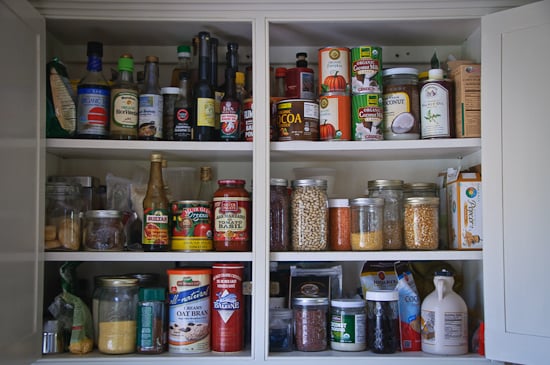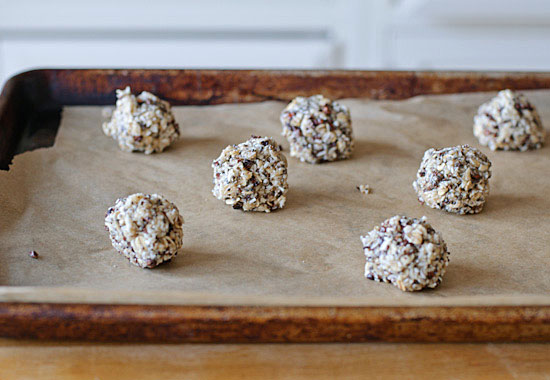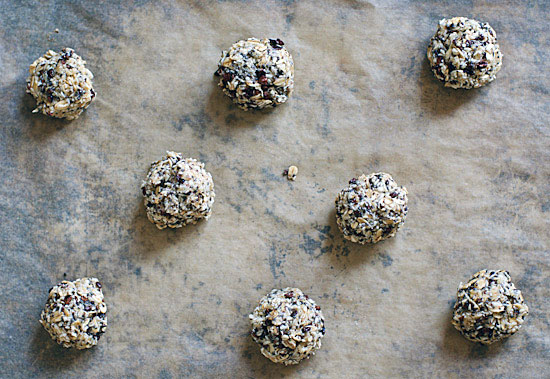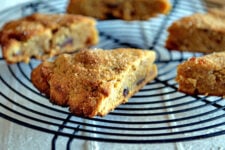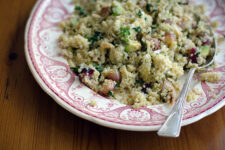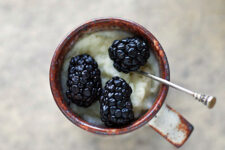Welcome to post #14 of One Simple Change: my year long series of tips dedicated to enhancing your health and your life. Sorry I’m a little late with this one, folks…last week got away from me so I couldn’t get this up on Friday as planned. Since it’s Tuesday and I am on track to have another post done this Friday, this week you’ll get a double dose of One Simple Change!
If you’ve been following along since the beginning of this series, you might remember that I wrote about “letting go” a while back. If you’re new to my blog or simply need a refresher, feel free to go read that post now.
It’s always good to clear out unnecessary junk, right?!
Today, inspired by my friend Alana’s newly published book The Homemade Pantry: 101 Foods You Can Stop Buying and Start Making, I want to help you revamp your pantry so it’s healthy, green, and completely awesome.
I want to encourage you not only to clear your kitchen of foods that are not healthy- this means all packaged and processed foods, as well as all ingredients that aren’t natural- but to restock your pantry with all the staples you need to create wholesome, nourishing meals for you and those you love to feed.
According to wikipedia, “a pantry is a room where food, provisions, dishes, or linens are stored and served in an ancillary capacity to the kitchen. The derivation of the word is from the same source as the Old French term paneterie; that is from pain, the French form of the Latin panis for bread”.
In today’s world, a pantry can take many forms. You might have a walk-in closet adjacent to your kitchen, but you might live in a tiny apartment and just have a cabinet or two for pantry items. What I consider to be my pantry is the contents of several different cabinets in my kitchen, plus items in a re-purposed hall closet, where we built shelves in order for it to function as a pantry. Here’s a peak into one of my cabinets:
My pantry did not become fully stocked with staples overnight: it has taken a good deal of time to accumulate all the things that I now keep on hand in my kitchen. I rarely cook the same meal twice, and I like to experiment with all sorts of ethnic dishes, so I enjoy keeping lots of interesting ingredients around. But with the exception of stopping into a specialty shop like Kalustyans every six months or so to pick up things I can’t find in my town, I buy all my pantry staples locally, either at a standard grocery store or at my favorite natural foods store.
My goal with respect to my pantry is to know that I can throw together a wholesome, tasty meal with what I have on hand at any time. I want to be able to make any recipe I see online, or in a cookbook or magazine, with a very minimal amount of shopping for ingredients. Since I have so many staples, and since I am trying to make more and more homemade pantry items, I find myself needing to go to the store less frequently. I keep my own chickens for eggs, and get my milk raw from a local farm, so just need to shop for the rest of the fresh foods we need each week. And as we get into the growing season, I’ll be shopping even less from the store, and gathering more food from my garden.
Below you will find the staple items I keep in my pantry. Please know that this does not mean you need to get everything listed…far from it! Your definition of a kick-ass pantry could be quite pared down compared to mine (and if you think I am a complete lunatic, I am okay with that), but I’m just telling you what works for me. I am including refrigerated kitchen staples that aren’t super perishable on this list because I consider these pantry items, but I am not including staple dairy products or most of the things I keep in the freezer because this post is way too long as it is! I hope this is helpful, and please do let me know if my pantry is missing something really important ;)
Fats and Oils
Please see this post and this one for more details on this topic.
Olive oil- extra virgin organic (for everyday cooking) and fancier/imported extra virgin organic (for salads and drizzling over special dishes)
Extra virgin organic coconut oil
Cold pressed sesame oil
Toasted sesame oil
Ghee = clarified butter
Butter, organic- salted and unsalted (stored in refrigerator)
Cold pressed flax oil- stored in the refrigerator
Avocado oil
Peanut oil
Toasted Walnut oil
Hot pepper sesame oil
Lard (pastured, organic)- stored in freezer
Sometimes I have other cold-pressed nut/seed oils like pumpkin seeds oil…I love these for salad dressings and other non-heated uses
Whole (not “lite”) organic coconut milk (I keep at least 2 cans on hand at all times)
Vinegars
Apple cider vinegar (raw and organic)
Balsamic vinegar
Brown rice vinegar (organic)
Champagne vinegars
Red and white wine vinegars
Sherry wine vinegar
Homemade vinegars (raspberry, pine needle and other varieties I make on occasion)
Nuts and Seeds
It’s best to keep these in the refrigerator if you have room: they’ll stay fresher for longer that way. It’s also best to buy nuts and seeds raw (if you can) and toast them yourself.
Walnuts
Almonds
Pecans
Cashews
Hazelnuts
Pine nuts
Sunflower seeds
Sesame seeds- white and black
Pumpkin seeds
Chia seeds
Ground flax seeds (I store these in the freezer)
Nut and seed butters (also stored in the refrigerator): almond butter, cashew butter, sesame tahini, organic peanut butter
Legumes
I buy dried beans in bulk, and store them in glass jars. I also keep a few cans of organic black beans and chickpeas on hand for times when I forget to pre-soak the dried ones.
Adzuki beans
Black beans
White/cannelini beans
Chickpeas/garbanzo beans
Kidney beans
Pinto beans
Split peas
Lentils: green and red
Split mung beans (yellow)
Whole mung beans
Rices and Grains
Arborio rice
Sushi rice
Quinoa- regular, black, red
Millet
Amaranth
Organic brown rice (short grain, long-grain, and jasmine)
Organic rolled oats
Organic steel-cut oats
Oat bran
Organic corn grits/polenta
Organic cornmeal
Noodles:
Rice noodles- I’ve got both thin and wide/flat ones (for Asian dishes)
100% buckwheat soba
Organic white flour pastas and whole grain low glycemic pastas
Sweeteners
Raw local honey
Pure maple syrup
Organic, fair-trade sugar: white and brown
Organic coconut sugar
Molasses
Jaggery
Palm sugar
Muscovado Sugar
Salty Sauces (and other Bottled Ingredients for Asian Dishes)
Wheat-free tamari
Bragg’s liquid aminos (a natural soy sauce high in amino acids)
Ketjap manis (Indonesian soy sauce)
Mirin (Japanese rice wine)
Thai fish sauce (keep refrigerated)
Sriracha and Asian chili garlic sauce- sometimes homemade/otherwise store-bought (keep refrigerated)
Dried Fruits
I buy dried fruits without added sugar; I also prefer those with zero or minimal preservatives.
Apricots
Dates
Figs
Raisins
Dried cherries
Tomato Products
Sun-dried tomatoes (homemade and store-bought)
Canned organic crushed tomatoes
High quality tomato sauce (no sugar added)
Organic tomato paste
Baking Staples
Non-aluminum baking powder
Baking soda
Homemade vanilla extract
Canned organic pumpkin
Crystallized ginger (sometimes homemade, otherwise store-bought)
Organic, fair-trade cocoa powder
Organic, fair-trade dark baking chocolate/chips
Cacao nibs
Flours, Starches, etc. for Regular and Gluten-Free Baking
Stone ground whole wheat flour
Whole wheat pastry flour
Organic unbleached white flour
Semolina flour
Buckwheat flour
Teff flour
Brown rice flour
White rice flour
Chickpea flour
Amaranth flour
Potato starch
Cornstarch
Coconut flour
Almond flour
Hazelnut flour
Miscellaneous
Dried mushrooms
Freeze dried organic coffee (decaf)
Organic black, green, and various herbal teas
Pomegranate molasses
Rose water
Orange blossom water
Shredded unsweetened coconut
Seaweeds- nori, hijiki, wakame
Organic popping corn
Nutritional yeast
Powdered wasabi
Sardines (2-3 tins/wild-caught)
Tuna (2-3 cans/wild + sustainably caught)
Vanilla rice milk
Rice crackers
Stocks: chicken and vegetable (I make big batches of these myself and store them in the freezer)
Homemade canned goods- jams, jellies, boozy fruits, etc.
Salts and Peppers
Sea salt- fine, coarse, and smoked/flaked
Kosher salt
Pink Himalayan salt and other specialty salts: ex. red, black
Homemade finishing salts: citrus, matcha, etc.
Black pepper
White pepper
Cayenne pepper
Crushed red pepper
Dried Herbs and Spices:
Too many to list here! I’ve got quite a collection :)
These coconut oat sesame bites (call me childish, but I cannot bring myself to call them balls) are just the kind of thing you can throw together on a whim when you’ve got a well-stocked pantry.
My mom moved away late last week. She and I have lived in the same town for the past 10 years, and now she and her husband are off to Colorado to be near my brother and his family. It feels very strange that they’re gone, and I considered making some crazy decadent chocolate chip cookies in reaction to my sadness (never a good idea).
I went with these frozen raw cookies inspired by Elizabeth’s recipe for chocolate chia energy balls instead, however, and I am very glad that I did.
[cft format=0]
Today is the last day to enter my giveaway to win 1 of 3 copies of Alana Chernila’s newly released cookbook The Homemade Pantry: 101 Foods You Can Stop Buying and Start Making. If you are interested in learning how to make pantry items from scratch instead of buying them from the store, this fabulous book is for you :)
Recipe for Coconut Oat Sesame Bites
Ingredients
- *1 cup organic unsweetened shredded coconut
- *1/2 cup tahini/sesame butter (I used raw tahini but you could use roasted; you can also use another type of all natural unsweetened nut or seed butter, such as peanut butter
- *1/4 cup maple syrup
- *1/2 cup organic rolled oats make sure to use gluten-free oats if you eat gluten-free
- *2 tablespoons cacao nibs
- *2 tablespoons chia seeds
Instructions
- 1. Place all ingredients in a large bowl and use a wooden spoon to mix well. Taste and adjust flavors/add more sweetener, if you like.
- 2. Form pieces of the "dough" into balls, and place on a parchment lined baking sheet.
- 3. Transfer to the freezer and allow to chill for several hours before eating. Store leftover balls in a freezer safe container in layers separated by parchment paper.

